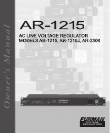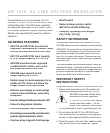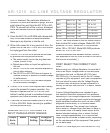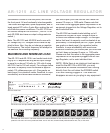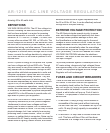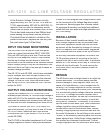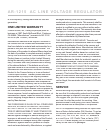
A R - 1 2 1 5 A C L I N E V O LTA G E R E G U L AT O R
drawing 40 to 50 watts total.
DEFINITIONS
VOLTAGE REGULATION: The AC line voltage is a
number indicating the nominal electrical potential
that has been adopted in a region for powering
electrical equipment of all kinds. In most of North
America it is 117 volts AC; in Japan, 100 volts; and
in many other countries 220, 230, or 240 volts. The
actual voltage can fall below or rise above this nomi-
nal level due to brownouts, power cutbacks, use of
substandard wiring, and other causes. These devia-
tions can cause poor performance or a malfunction.
A regulator is a device which, through use of a trans-
former, corrects the voltage deviation by stepping it
up or down so that it is as close as possible to the
nominal level.
SPIKE: A pulse of energy on the power line. Spikes
can have voltages as high as 6000 volts. Though
they are usually of very short duration, the energy
they contain can be considerable, enough to dam-
age sensitive solid-state components in audio and
computer equipment. Spikes can also foul switch
contacts and degrade wiring insulation. They are
an unavoidable component of electric power. They
are caused unpredictably by electric motors switch-
ing on or off (on the premises or outside), utility
company maintenance operations, nearby lightning
strikes, and other factors. Spikes (also called surges
or transients) are absorbed by special components
called MOV’s in the AR-series to provide safe volt-
age levels to protect your equipment.
RFI/EMI INTERFERENCE: Noise from RFI (Radio
Frequency Interference) or EMI (Electro Magnetic
Interference) involves lower voltages and less
energy than is found in spikes, but it is continuous
rather than transient in nature. It is not likely to cause
physical damage, but it can certainly be annoying,
producing static in audio circuits, “snow” on video
screens, or garbled data in computers. Noise can be
introduced into AC lines by nearby radio transmitters,
certain kinds of lighting, electric motors, and others.
Because noise occurs at higher frequencies than
the 50 or 60 Hz AC line, it can be effectively reduced
through use of low-pass fi ltering.
EXTREME VOLTAGE PROTECTION
The AR-Series includes special circuitry to sense
over- and under-voltages and positively shut down
the output before possible damage is done. See
the Specifi cations on the back page for the exact
voltages at which shutdown occurs. When the input
voltage exceeds the limit, the power will cut off. It will
come back on automatically when the overvoltage
is removed as long as the voltage has not exceeded
300V [all models]. The red LED labelled EXTREME
VOLTAGE SHUTDOWN indicates the shutdown
condition. The output is also shut down for extremely
low input voltages.
To provide protection against a catastrophic error in
AC mains wiring, dangerously high voltages (those
over approximately 300V) will cause an internal fuse
to blow, but equipment plugged into the Voltage
Regulator will not be damaged.
FUSES AND CIRCUIT BREAKERS
There is one fuse and one circuit breaker in the
AR-Series. In the event that the unit appears to
be completely dead (neither the Power switch nor
any LED’s light up), unplug the power cord and the
load and check the breaker. If the circuit breaker is
tripped, a white button will pop up. Push it back in
to reset it. The purposes of these circuit protection
devices are:
1. A fast-blow 15 amp [6 amp] circuit breaker is
accessible at the rear panel without removing
the unit from the rack. This breaker will trip if the
unit’s 15 amp [6 amp] capacity is exceeded at
any time.
2. A fast-blow 1/4 amp fuse is located inside the
unit. This fuse will blow if the unit has been
connected to a voltage that is above the range
4



